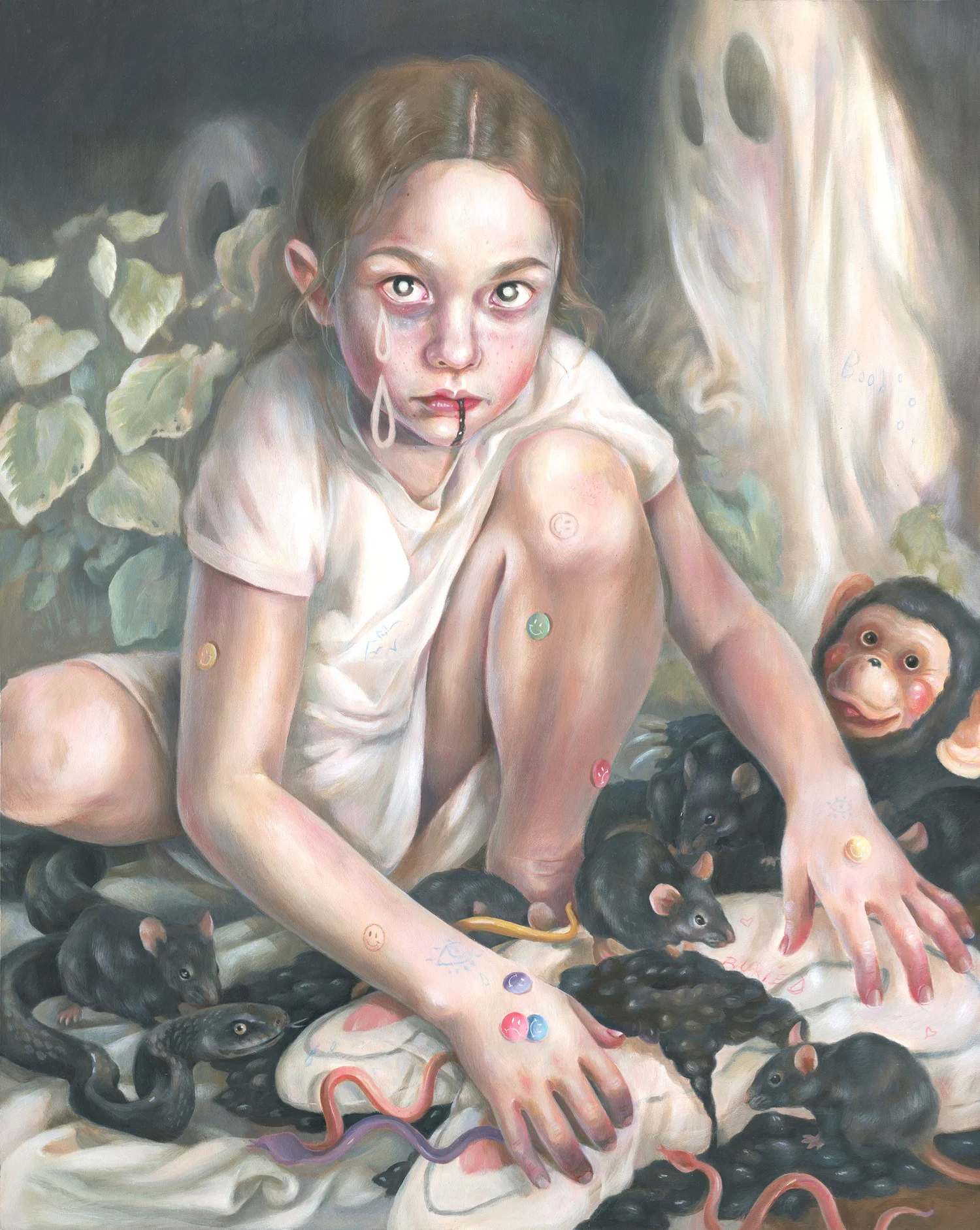Contemporary women
I choose to talk about some of my favorite contemporary painters and continue to produce work in the present. All of the artists featured here are women, and so are the subjects of their portraits. They represent all kinds of points of view on feminity.
The representation varies, but all are surrealist, with some lowbrow elements and the romanticization of the female gaze.
Miss Van
Miss Van started painting in 1993 in Toulouse, France. Although she has spent most of her life in Barcelona. Initiating the feminine movement in Street Art. Her representation of women is instantly recognizable; she has murals in Europe, the USA, and Asia.
Her works are filled with emotion and romantic darkness, and delicacy. Her iconic Sultry female characters appear in surreal burlesque motives, with sensual but dark animal masks and dangerous involving surroundings. My favorite aspect is how tired they look as if they could eye-roll you at any point.
There is a quality of softness, wilderness, and emotion in these women that one can relate to.
Moth Muse's Mural, The Crystal Ship Festival, Oostende, Belgium, 2019
Retrato Flora I, Paintings 2021
Dougni Hou
Born in 1987, Dougni Hou has been painting since she was 19. Most of her work has been displayed in galleries and entered private collections. She tells the story of humanity, walking through a fragile line of what is soft and rigid but beautiful nevertheless.
Her motives are very romantic: knights, girls in gowns, flowers... But these portraits of women do not feel vulnerable in any way. They might be hurt, in tears, or carrying the weight of a fight, but their gazes are determined and full of understanding.
Her portraits usually have no backgrounds, much like Velazquez; she frames the figure on a blurry neutral tone and casts some shadows to give it dimensionality. They all seem to be illuminated by cold blue light, as if the scene happens at night, in the dark.
By the end of the day, one way or another, we all need some illusions to carry on. 2022, guache, 73x56 cm
I must also have a dark side if I am to be whole, 2022, gouache, 80x69cm.
When the going gets tough, the thought gets going, 2022, gouache, 61x51 cm
Then the night is darkest just before dawn, 2021, gouache 61x50cm.
Hanna Jaeun
She originally started as a Designer but decided to pursue her dreams as a painter. She has exhibited chiefly around the USA. Her preferred medium is acrylic on wood, and she draws inspiration from religious paintings, puppetry, and animals.
Her compositions talk about isolation, vulnerability, and the yearning to belong. In her word, childhood is macabre. The kids are terrified, apathetic, or surprised. Eyes red from crying, mysterious wounds, and blood dripping. They seem trapped in neverending nightmares, scenes of innocent playtime mixed with ghosts, demons, and rats.
Her beautiful illustrations invoke memories of the dark side of childhood and the loss of innocence. They are very bittersweet to me.
Burial of the Past
16” x 20” acrylic on wood panel
Once Shy 5" x 7"
acrylic on wood panel
Hiding Behind a Smile"
18” x 24” acrylic on wood panel
Sources:
Dongni Hou. Laurence Esnol Gallery. (2023, January 26). Retrieved April 19, 2023, from https://www.laurenceesnolgallery.com/dongni-hou/?fbclid=PAAaY6ByTKKX3BwVMTTs_KdI-ajh0o01hoyefi1AwPYM2oBehrAhwj_DyZLgc
Dongni Hou. Yveline Antiquités. (n.d.). Retrieved April 19, 2023, from https://www.yveline-antiquites.com/en/2021/01/11/dongni-hou/
Jane, D. (2020, May 29). Dark artist Hanna Jaeun discusses her life in the epicenter of the pandemic. Upon a Midnight Dreary. Retrieved April 19, 2023, from http://uponamidnightdreary.com/interviews/dark-artist-hanna-jaeun-discusses-her-life-in-the-epicenter-of-the-pandemic/
Hanna Jaeun Website. Hanna Jaeun. (n.d.). Retrieved April 19, 2023, from https://hannajaeun.com/new-page
Miss Van's website. Miss Van. (2023, April 16). Retrieved April 21, 2023, from https://www.missvan.com/










Comments
Post a Comment